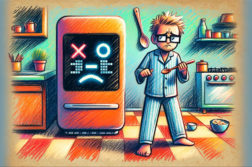Small photocopied publications with tiny print runs, zines are pure independent authorship, unique artwork, deeply personal stories, wry observations, bad drawings — basically whatever the maker wants them to be. Cheap or stolen photocopying allows for easy distribution. DIY doesn’t always spell quality, but amid the self-indulgent junk there are enough gems to sustain an entire subculture.
I’ve been making zines for 12 years. For the last half dozen or so, a trip to Melbourne has included a pilgrimage to the pink-tiled Degraves Street Subway where lurks the Sticky Institute. It smells like toner in there and all available shelving is covered in self-published delights.
Retail and DIY don’t often mix but Sticky has been in operation for eight years. With a 20 per cent commission on zines which usually sell for between $1 and $5, they can’t be making much. The shop forms part of an artist-run initiative and receives some funding from arts bodies and the City of Melbourne.
Shop manager Luke Sinclair has been involved with the zine world since the early 1990s, when zines started disappearing from indie record store racks. "I thought that some of the work I was encountering in zines at the time was amazing — works of art that deserved to be put in pride of place rather than hidden away under the counter," he says.
Now in 2009, another zine shop has opened. Format is tucked away in Peel Street, central Adelaide. It’s also an office space, which is shared with street press magazine Merge. Format was closed when I visited, but I managed to get volunteer Sam Rodgers on the e-blower.
Format is an "arts and literature collective" which started as a DIY festival three years ago, says Rodgers. In 2009 they had "outrageous success" as part of the Adelaide Fringe and Rodgers tells me that he "didn’t want that culture to die throughout the rest of the year". In true punk rock style they managed some of their start-up costs with alcohol sales. They also have grant money, which enables them to pay zine makers.
So what’s so great about zines? Actually, 90 per cent of them are crap. But that’s not the point. The possibility of unconstrained creativity allows for a fabulousness that can’t happen in the cautious, slow-moving world of publishing. In the zine world, profit and loss don’t apply and editors don’t exist. Zines are obsessive, unusual, personal, flawed and proudly ephemeral. They are often anti-copyright and can’t be bought and sold by Google lawsuits.
But what is the impact of the digital age on these photocopied gems? Rodgers says: "I don’t see zines ‘evolving’ into anything electronic, the same way I don’t think ebooks will render real books defunct any time soon. People like to take a book with them on public transport, or to the toilet, or to bed. Zines are in that same physical dimension."
Ebook readers do offer self-publishing possibilities. If the technology takes off, we might see zine-makers selling their work via sites like smashwords, which does the tricky file conversions and provides the online shopping infrastructure. More earnest types might choose to upload their work to BookServer, the open source ebook project launched by Internet Archive in October.
But most zine makers see their handiwork as physical objects, traded in a network separate to the online world. Unlike publishers, they don’t have a market to lose. The bogeyman of the internet is therefore a bit of a joke to zine makers. In contrast to mainstream publishers, if you ask a zinester if digitisation threatens their craft he or she simply looks up from his or her long-arm stapler and sighs.
Maybe we’re talking parallel evolution here. When the internet came along, zines provided a ready-made subculture of memoirism and cut-and-paste which fed into the online format. Zines are ancestral relatives to blogs and the band-based fanzine is the template for MySpace.
Rapid evolution in publishing has blurred the lines between zines and books, though, and this has been the source of much discussion in zine shops. Sticky doesn’t stock books (they don’t have much room), but it isn’t always easy to tell what a book is. "Usually the spine is a dead giveaway," Sinclair says. There are always exceptions. On my trip to the shop I picked up a copy of How to Make Trouble and Influence People (Breakdown Press), a people’s history of Australian activism which began as a zine in 1996 and still has the zine-y cut-and-paste sense of adventure about it, combined with professional layout and a bookish spine. Format stocks books which "have either been made by a zinester out of their own pocket, or published by an independent publisher … the latter aren’t zines in the traditional sense, but they share the same spirit of not being biographies about Shane Warne".
Some zinesters end up as ‘real’ writers, like my contemporaries Tom Cho and Vanessa Berry. Most of us continue to make zines in parallel with our writing careers. Pseudonyms are common. As quality printing gets cheaper, long-term zines are sometimes anthologised as books. There are many talented young writers in the zine world but the zine is not a stepping-stone on the way to real publication and people who think otherwise are encouraged to leave.
Sinclair says "A zine-reading audience can smell a ‘springboard’ a mile away and stays away like the plague," and adds: "If you are going to make a zine you are going to lose money so you may as well be doing something you love."
It’s a defended but inclusive tribe. Zines are usually swapped or sold at fairs. The largest of these is held at Newcastle in October, part of the ‘This Is Not Art’ cluster of festivals. Sticky runs the ‘Festival of the Photocopier’ each February and Format has a festival in March that’s "fringier than the Fringe".
These festivals, particularly Newcastle, are expanding rapidly. That has its own issues for a culture so defiantly underground. In the 1980s and ’90s, fanzines were usually stocked in indie record shops, but this shifted as music went digital. When zines broke up with rock and roll, they started to date knitting. In the last few years, DIY culture has fed an enormous craft renaissance. These days zine fairs are often crowded out by crocheted cupcakes and cute cartoon animal badges — so much so that some fairs are now advertised "zine only"!
Rodgers thinks that sort of thing is pretty harmless. "It’s just a part of the changing landscape of zine culture. I’m sure at one point someone complained that there were too many fanzines in the ’80s." Sinclair is more of a purist. "Zine fairs should be for zines alone," he says. As for the shop, "[if]you start stocking T-shirts and records and books, all of a sudden you don’t resemble a zine shop at all and you resemble every other hipster boutique in the world."
The point of DIY culture is that it doesn’t resemble everything else. It’s certainly recruiting a new generation. Says Sinclair: "The kids are hip to zines these days because they are digital natives seeking the ‘other’. The kids at school these days are so used to mass production that anything original truly blows their mind."
The interest level among Melbourne’s youth is such that Sticky has a sheet of butcher’s paper on their door where visiting high school kids can mark their attendance. At the end of the year the ‘hippest high school tally’ is counted. The 2009 winner? MacRobertson Girls’ High. Their principal has been sent a letter of appreciation from the staff at Sticky which "they will no doubt read out at assembly".
Sticky’s presence is certainly a part of the growth of grassroots publishing that has fed Melbourne’s status as a City of Literature. While the Wheeler Centre hasn’t been knocking on their door yet, zines are starting to come under the radar of the literary establishment. There’s a zine fair at the Sydney Writer’s Festival. 2009 was the first year the Australia Council recognised zines as publications in their selection criteria for emerging writers grants. Despite the discouragement of "springboarders" it’s clear the medium is a rich primordial soup of emerging culture. And that creative habitat can be very sustaining.
"Having a visible zine presence in the city that is there around the year cannot be under-estimated. We have brought literally thousands of zine titles to Melbourne that might never have made it here otherwise and that inspires and makes people make more zines and better zines," says Sinclair.
The low cost of digital print certainly means that young zine-makers are creating more technically interesting and colourful work. Sure, most of it is still crap. But whatever the future of the book in this age of instant gratification, the delayed but charming gratification of the photocopier will be around for a while yet. Says Rodgers: "Seriously, you should never stop, unless your friends give you an intervention and plead with you to lay off the toner."
Donate To New Matilda
New Matilda is a small, independent media outlet. We survive through reader contributions, and never losing a lawsuit. If you got something from this article, giving something back helps us to continue speaking truth to power. Every little bit counts.



